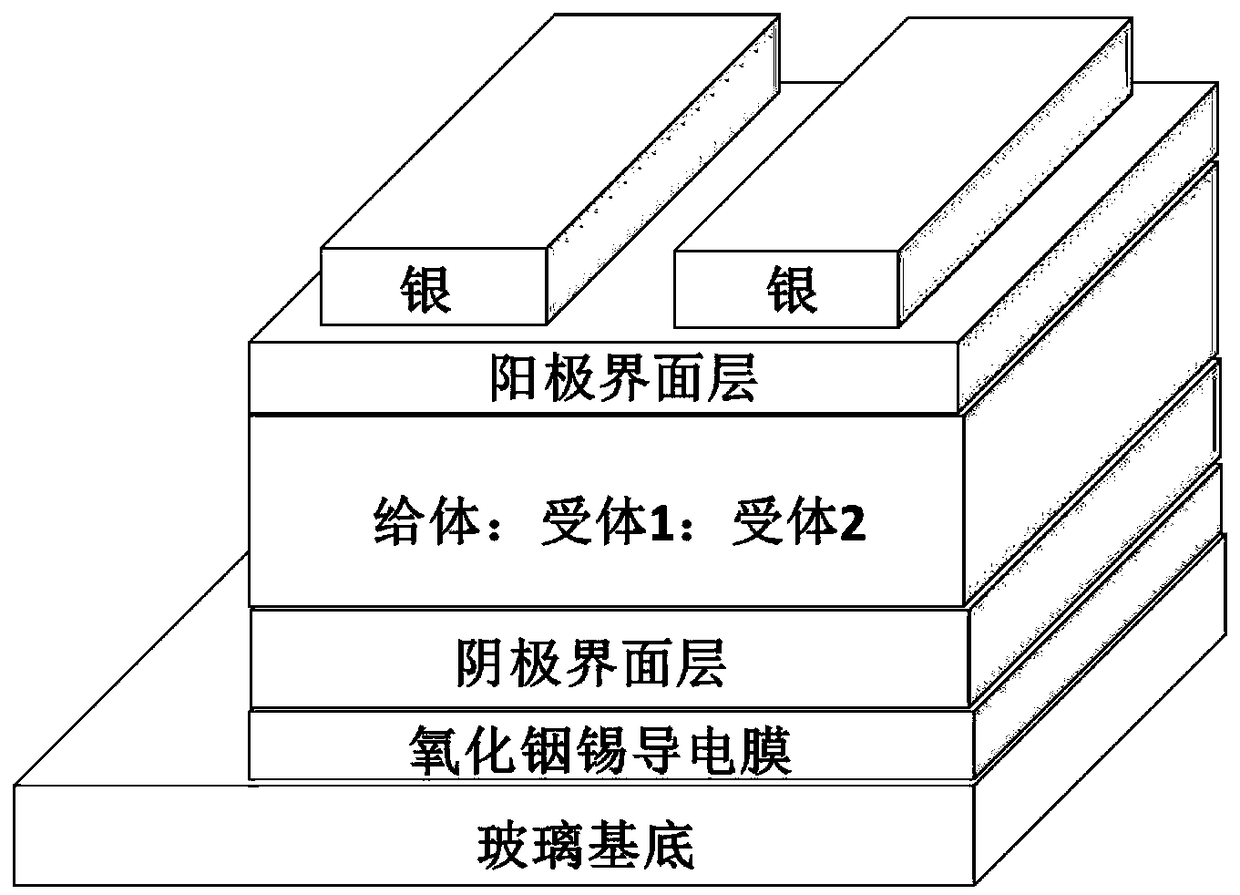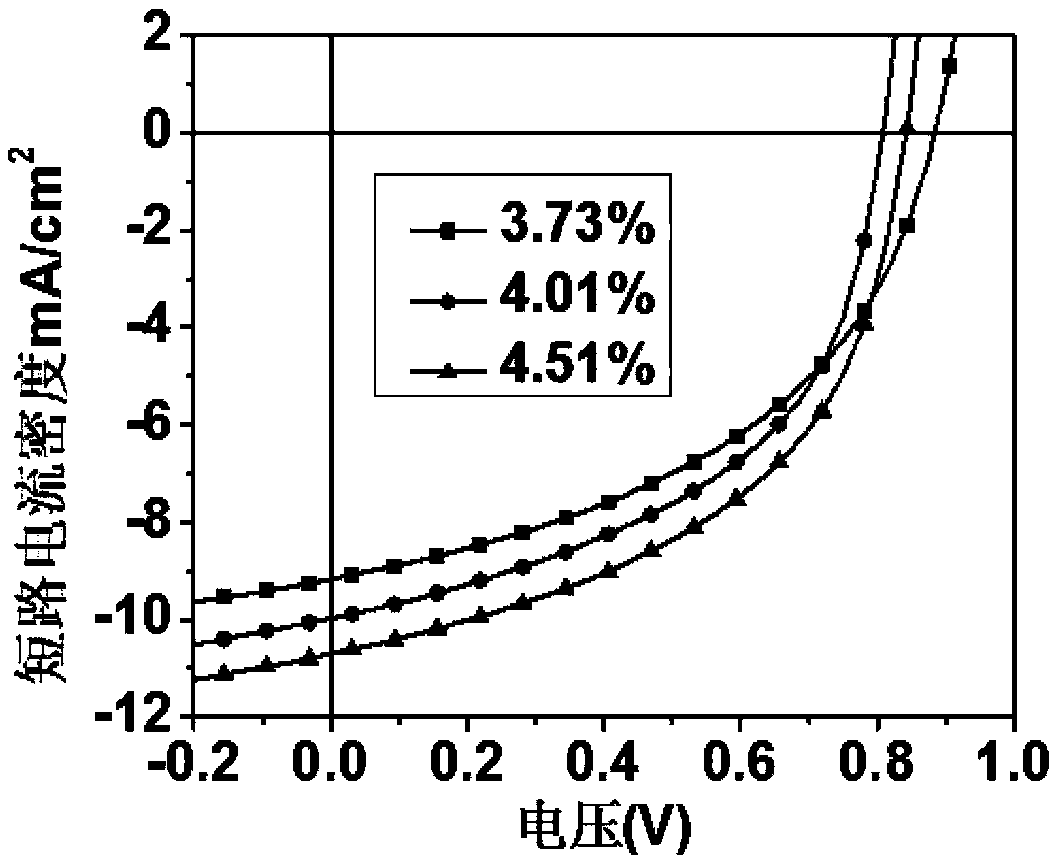Ternary polymer solar cell
A technology of solar cells and ternary polymers, applied in circuits, photovoltaic power generation, electrical components, etc., to achieve the effects of improving photoelectric conversion performance, inhibiting bimolecular charge recombination, and improving phase separation
- Summary
- Abstract
- Description
- Claims
- Application Information
AI Technical Summary
Problems solved by technology
Method used
Image
Examples
Embodiment 1
[0046] Control group:
[0047] Clean the substrate composed of transparent substrate layer and transparent conductive cathode ITO with surface roughness less than 1nm, and blow dry with nitrogen after cleaning; spin-coat ZnO (4500rpm, 40s, 25nm) on the surface of transparent conductive cathode ITO to prepare cathode buffer layer, and the formed film was thermally annealed (200°C, 60min); the PTB7-Th:N2200 photoactive layer (2000rpm, 60s, 95nm) was prepared by spin coating on the cathode buffer layer, and the mass ratio was 1:1; Evaporation of MoO on the surface of the photoactive layer 3 (8nm); metal anode Ag (80nm) was vapor-deposited on the anode buffer layer. Under standard test conditions (AM1.5, 100mW / cm 2 ), the measured open circuit voltage of the device (V OC )=0.80V, short-circuit current (J SC )=11.2mA / cm 2 , fill factor (FF) = 0.45, photoelectric conversion efficiency (PCE) = 4.01%.
Embodiment 2
[0049] Clean the substrate composed of transparent substrate layer and transparent conductive cathode ITO with surface roughness less than 1nm, and blow dry with nitrogen after cleaning; spin-coat ZnO (4500rpm, 40s, 25nm) on the surface of transparent conductive cathode ITO to prepare cathode buffer layer, and the formed film was thermally annealed (200°C, 60min); the PTB7-Th:N2200:2PDINB photoactive layer (2000rpm, 60s, 95nm) was prepared by spin coating on the cathode buffer layer, and the mass ratio was 1:1 :0.1; evaporate MoO on the surface of the photoactive layer 3 (8nm); metal anode Ag (80nm) was vapor-deposited on the anode buffer layer. Under standard test conditions (AM 1.5, 100mW / cm 2 ), the measured open circuit voltage of the device (V OC )=0.80V, short-circuit current (J SC )=11.5mA / cm 2 , fill factor (FF) = 0.45, photoelectric conversion efficiency (PCE) = 4.07%.
Embodiment 3
[0051] Clean the substrate composed of transparent substrate layer and transparent conductive cathode ITO with surface roughness less than 1nm, and blow dry with nitrogen after cleaning; spin-coat ZnO (4500rpm, 40s, 25nm) on the surface of transparent conductive cathode ITO to prepare cathode buffer layer, and the formed film was thermally annealed (200°C, 60min); the PTB7-Th:N2200:2PDINB photoactive layer (2000rpm, 60s, 95nm) was prepared by spin coating on the cathode buffer layer, and the mass ratio was 1:1 :0.2; evaporate MoO on the surface of the photoactive layer 3 (8nm); metal anode Ag (80nm) was vapor-deposited on the anode buffer layer. Under standard test conditions (AM 1.5, 100mW / cm 2 ), the measured open circuit voltage of the device (V OC )=0.82V, short-circuit current (J SC )=12.1mA / cm 2 , fill factor (FF) = 0.45, photoelectric conversion efficiency (PCE) = 4.52%.
PUM
| Property | Measurement | Unit |
|---|---|---|
| Thickness | aaaaa | aaaaa |
| Short circuit current | aaaaa | aaaaa |
| Short circuit current | aaaaa | aaaaa |
Abstract
Description
Claims
Application Information
 Login to View More
Login to View More - R&D
- Intellectual Property
- Life Sciences
- Materials
- Tech Scout
- Unparalleled Data Quality
- Higher Quality Content
- 60% Fewer Hallucinations
Browse by: Latest US Patents, China's latest patents, Technical Efficacy Thesaurus, Application Domain, Technology Topic, Popular Technical Reports.
© 2025 PatSnap. All rights reserved.Legal|Privacy policy|Modern Slavery Act Transparency Statement|Sitemap|About US| Contact US: help@patsnap.com



